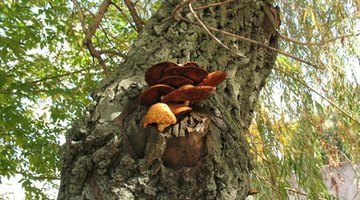Tree Fungus Art
Tree fungus art is a decorative craft that uses shelf fungus as a canvas. Shelf fungus, also called artist's conks, is a large growth that attaches to live tree trunks and fallen lumber. This natural material has a flat surface and wide base, making it ideal for use as a free-standing decoration.

Harvesting
Ganoderma applanatum is the variety of fungi used for tree fungus art. This particular fungi can be found in most any state and at any time of year. Summer harvesting results in a moist, fresh specimen best for use in pyrography, a drawing technique where designs are burned into a canvas while winter harvesting yields a stiff, dry fungus that is more suitable for painting. When picking shelf fungi, grasp the base of the fungus; touching the surface of the growth will cause bruising on its surface. Cut the base of the fungus close to the tree trunk with a hand saw or ax, and level the base with whittling tools or a craft knife before the fungus dries completely.
Preparation
Shelf fungi can be used for pyrography directly after picking. The moisture in the fungi does not hinder burning and will evaporate over time. Dry shelf fungi completely before painting. Place cut fungi outdoors in an area with direct sunlight and good air circulation to speed up the drying process; a primer or base coat is not necessary. However, like wood, shelf fungus has a grain and pores. If this natural texture hinders your painting technique, apply one to two coats of primer.
Media
Traditionally, shelf fungus has been used for pyrography; however, any two-dimensional medium can be used to decorate shelf fungus. When selecting a medium, consider the effect that particular properties will have on the fungus. For example, hard media, such as pencils and pastels, may bruise, tear or puncture the surface of the canvas, which may or may not be desirable. Dry media, such as chalk, pastels and charcoal, necessitate the use of a dry shelf fungus. All media benefit from the application of a protective coating, like varnish or clear acrylic spray, to the canvas.
Care
To clean tree fungus art, dust the piece with a dry cloth or feather brush. Do not use harsh cleaners or submerge it in water. Remember that tree fungus art is organic and susceptible to all of the same problems as wood, namely mold. To prevent mold growth, keep the fungus away from excess moisture. If your shelf fungus art gets wet, place the piece in direct sunlight in a well-ventilated area.
References
- Genge's Art Studio: Artist Fungi
- Mushroom-Collecting.com: Artist's Conk
- "Popular Science"; Drawing On Fungus; Anthony Zipprich; February 1921
- "A Field Guide To Mushrooms: North America"; Kent H. McKnight, Vera B. McKnight, Roger Tory Peterson; 1998
Writer Bio
Sylvia Cini has written informative articles for parents and educators since 2009. Her articles appear on various websites. Cini has worked as a mentor, grief counselor, tutor, recreational leader and school volunteer coordinator. She holds a Bachelor of Arts in psychology from Clark University of Worcester, Massachusetts.
Photo Credits
- fungus; image by ViewSonic from Fotolia.com
- fungus; image by ViewSonic from Fotolia.com
More Articles



